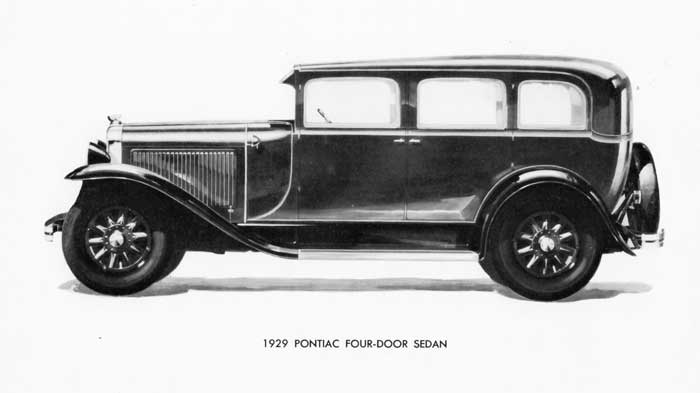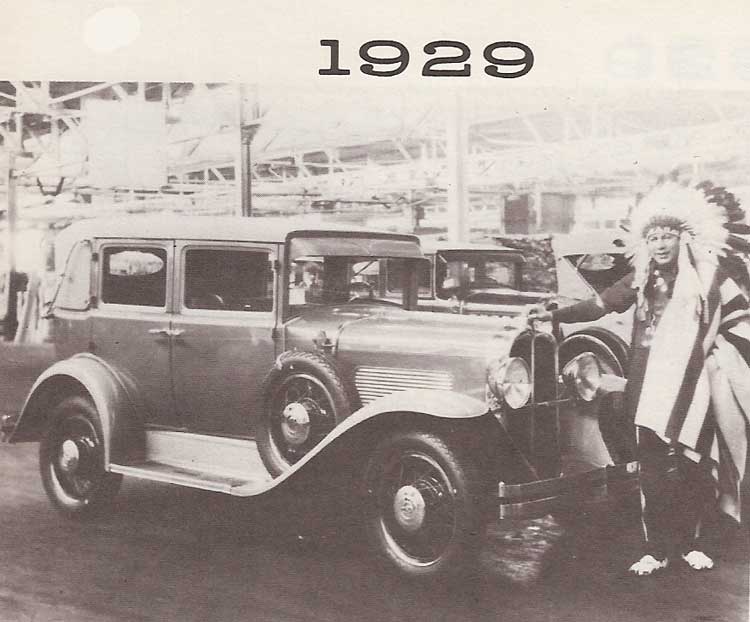
1929 Pontiac, A significant year.
The auto industry of the Twenties, Oakland included, would begin production of new models during the summer in anticipation of the next sales “season”. You may recall from the coverage of 1926 that the 4 door Pontiac appeared in August of that year; 1929 was the final year that Oakland followed this practice and that is part of what makes the ’29 Pontiac such an interesting subject.
Production of the “New Series” 6-28 models commenced in July of ’28 with vehicles that were nearly identical to the vehicles that preceded them. Among the changes to the “New Series” was one that made spotting them very easy; heavier 10 spoke wooden wheels replaced the previous 12 spoke units. The Carter carburetor gave way to a larger Marvel 1¼ inch single barrel and horsepower was increased as a result. Approximately 80,000 of these were produced as 1929 Pontiacs.
Introduced in January 1929, the New Big Six series 6-29 models arrived just in time for the winter new automobile shows around the country. Styling was done by W. Everitt Miller who had previously worked for the Murphy body works of Pasadena, California. Miller was employed to handle styling for Vauxhall automobiles in Great Britain, which General Motors had acquired in 1926; his efforts were all used on domestic models including Pontiac, LaSalle and Oldsmobile. In the case of Pontiac, the grille was “split” for the very first time with a thin vertical bar! Another easily seen feature of 6-29 series models was the use of horizontal hood louvers; these proved to be prone to warping due to engine heat and conventional vertical louvers returned to production in May and continued through the end of production in July. Total production of the New Big Six between January and the end of July was 120,000 units.
August of 1929 saw the introduction of the 6-29A Big Six; this would be the last time a mid-year series would carry into the next model year. The 6-29A was identical to the previous 6-29 series although 2 significant models were cut of the line-up; the convertible cabriolet and the 4 door landaulet. Over 60,000 were produced through the 31st of October when the 1929 model year officially ended for Pontiac.
The most significant model of the 6-29 series was the Landaulet; a 4 door job with functional landau irons supporting a collapsible fabric top that exposed the rear quarter of the passenger compartment. Photographs exist of both early and late models; that is to say, cars with vertical and horizontal hood louvers. I recently received a question about this particular body style and mistakenly replied without researching my answer that it may have been a Stewart-bodied Pontiac. A quick study on my part seems to indicate that the Stewart bodies were only used on roadsters and phaetons; and these abbreviated designations (ROAD & PHAE) appear in the model listings and the parts books. The Stewart bodies didn’t carry job numbers.
We’re fortunate to have several ’29 advertisements; it’s interesting to note that all of the ads show wire wheels, which all sources indicate were optional equipment, although no mention is made of this fact on any of the ads. Front and rear bumpers were optional; along with either a single or dual side-mounted spare tires; spare tire cover(s), pedestal mirror(s), wind wings for open cars, heater, spotlight, running lights and Lovejoy shock absorbers rounded out the list of optional equipment.
Technical improvements included counter-weighted crankshaft with harmonic balancer, larger intake manifold, (a necessity with the larger carburetor) and larger valves with increased lift which combined to provide a 20% increase in power. The 4-wheel mechanical brakes featured self-energizing action for the first time; the transmission and rear axle were also improved; another necessity due to the increase in power. This philosophy of continual product improvement and attention to even minor details served Pontiac very well; in combination with the vast resources of General Motors, Pontiac was able to offer the motoring public a product that was far superior to its direct competitors in size, performance and longevity.
The auto industry of the Twenties, Oakland included, would begin production of new models during the summer in anticipation of the next sales “season”. You may recall from the coverage of 1926 that the 4 door Pontiac appeared in August of that year; 1929 was the final year that Oakland followed this practice and that is part of what makes the ’29 Pontiac such an interesting subject.
Production of the “New Series” 6-28 models commenced in July of ’28 with vehicles that were nearly identical to the vehicles that preceded them. Among the changes to the “New Series” was one that made spotting them very easy; heavier 10 spoke wooden wheels replaced the previous 12 spoke units. The Carter carburetor gave way to a larger Marvel 1¼ inch single barrel and horsepower was increased as a result. Approximately 80,000 of these were produced as 1929 Pontiacs.
Introduced in January 1929, the New Big Six series 6-29 models arrived just in time for the winter new automobile shows around the country. Styling was done by W. Everitt Miller who had previously worked for the Murphy body works of Pasadena, California. Miller was employed to handle styling for Vauxhall automobiles in Great Britain, which General Motors had acquired in 1926; his efforts were all used on domestic models including Pontiac, LaSalle and Oldsmobile. In the case of Pontiac, the grille was “split” for the very first time with a thin vertical bar! Another easily seen feature of 6-29 series models was the use of horizontal hood louvers; these proved to be prone to warping due to engine heat and conventional vertical louvers returned to production in May and continued through the end of production in July. Total production of the New Big Six between January and the end of July was 120,000 units.
August of 1929 saw the introduction of the 6-29A Big Six; this would be the last time a mid-year series would carry into the next model year. The 6-29A was identical to the previous 6-29 series although 2 significant models were cut of the line-up; the convertible cabriolet and the 4 door landaulet. Over 60,000 were produced through the 31st of October when the 1929 model year officially ended for Pontiac.
The most significant model of the 6-29 series was the Landaulet; a 4 door job with functional landau irons supporting a collapsible fabric top that exposed the rear quarter of the passenger compartment. Photographs exist of both early and late models; that is to say, cars with vertical and horizontal hood louvers. I recently received a question about this particular body style and mistakenly replied without researching my answer that it may have been a Stewart-bodied Pontiac. A quick study on my part seems to indicate that the Stewart bodies were only used on roadsters and phaetons; and these abbreviated designations (ROAD & PHAE) appear in the model listings and the parts books. The Stewart bodies didn’t carry job numbers.
We’re fortunate to have several ’29 advertisements; it’s interesting to note that all of the ads show wire wheels, which all sources indicate were optional equipment, although no mention is made of this fact on any of the ads. Front and rear bumpers were optional; along with either a single or dual side-mounted spare tires; spare tire cover(s), pedestal mirror(s), wind wings for open cars, heater, spotlight, running lights and Lovejoy shock absorbers rounded out the list of optional equipment.
Technical improvements included counter-weighted crankshaft with harmonic balancer, larger intake manifold, (a necessity with the larger carburetor) and larger valves with increased lift which combined to provide a 20% increase in power. The 4-wheel mechanical brakes featured self-energizing action for the first time; the transmission and rear axle were also improved; another necessity due to the increase in power. This philosophy of continual product improvement and attention to even minor details served Pontiac very well; in combination with the vast resources of General Motors, Pontiac was able to offer the motoring public a product that was far superior to its direct competitors in size, performance and longevity.


Magazine Ad Links: Its a Big Car More for your Money Stepping up the Standard
